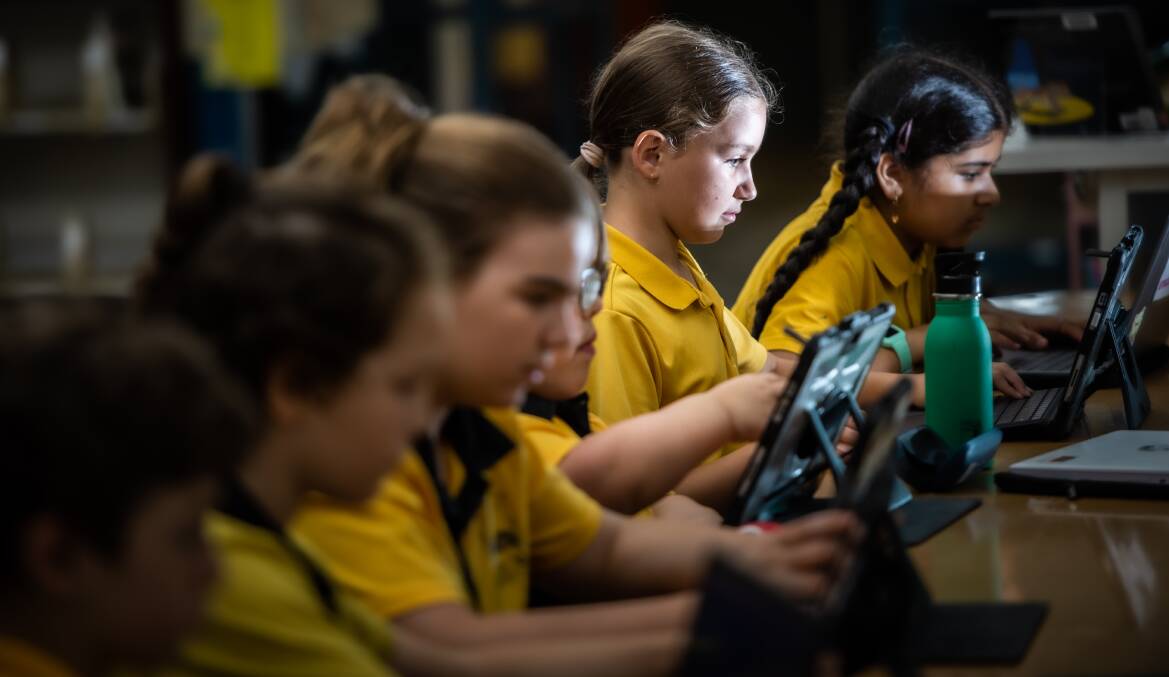
Students at Gordon Primary School are trying to build a wall to keep the foxes out of the castle each night.
The foxes are not real, thankfully, but they are part of a Minecraft Education game developed by Questacon to teach them about cybersafety.
Year 5 student Charlotte Robertson is feeding her chickens, collecting the eggs and trading with villagers to fortify her virtual castle.
"It's a fun way of learning things," she said.
Video games are increasingly coming into the classroom as researchers look into how they can be used to make learning engaging.
Australian Catholic University associate professor Laura Scholes, who works at the Institute for Learning Sciences and Teacher Education, was the lead researcher on a large-scale study into children's attitudes to video games and digital technology.
In the study, 613 students aged seven to 10 from 21 public and private schools were asked about how much they enjoyed gaming and how they rated their own digital skills.
The researchers were surprised to find students from a lower socioeconomic background reported they enjoyed video games more and rated their own digital skills more highly compared to their more advantaged peers.
They found girls in particular were less likely to enjoy video games as their socioeconomic status increased.

"That's a concern because these girls are really young and they're already deciding they don't like or don't engage with technology and are then losing confidence," associate professor Scholes said.
"Then we see girls who are not going into things like computer sciences and technology and this perpetuates into a problem where we're not getting girls going into those fields that are really in higher demand."
One explanation for the results is that more affluent children are occupied by extracurricular activities rather than spending time playing video games.
Boys could also be overestimating their skills as the study asked them to rate their own skills.
She said girls get turned off gaming at a young age because it is a masculine space and boys tend to dominate.
"There's lots of stereotypes that kick in at this age about what's an appropriate activity for a girl and for a boy so we we weren't surprised that boys enjoyed technology and gaming more than girls," she said.
"It's good news for teachers that want to engage boys. Often boys from lower socioeconomic communities are disengaged in reading so if they can use technology as a conduit to engage boys they can learn so much about reading and writing through gaming and through technologies and using things like Minecraft in the classroom."
While being addicted to gaming can have negative consequences, associate professor Scholes said parents and teachers should embrace it so students can reap the benefits.
"Gaming's used now for training in manufacturing and medicine and education and all sorts of things. Precision surgery now is being you know, the training is through gaming," she said.
"It's being mainstreamed in the workforce. So we have to engage with it in schools in healthy ways. And, you know, have have a framework or parameters around how it's how it's used."
Academy of Future Skills assistant director Melissa Bissett has been supporting ACT public school teachers to integrate digital technology into their teaching.
Gordon Primary School was part of a pilot program where Minecraft Education was put on Chromebooks. Students were able to enter a NAIDOC Minecraft challenge and also were some of the first students to test out Questacon's cyber castle challenge.
"Minecraft Education I think is a good platform. It's a great hook for getting kids in," Ms Bissett said.
"But I think it's really part of a bigger package in terms of the learning that needs to sort of sit around it, definitely aligned with the curriculum."
Ms Bissett said students were buzzing with excitement while doing the Minecraft challenges and it allowed some shy students to shine.
"I'd say there was some kids who ... engaging in class might be a little bit difficult, but it's certainly been a way of getting them engaged and learning," she said.
The ACT Education Directorate is now allowing any public school to apply to have Minecraft Education added to their Chromebooks. While the focus so far has been on STEM, the world of Minecraft can be used to teach language and literacy, history and culture or art and design.
"There's just a lot of positives about how you can use it but it's really about teachers being skilled up and giving it a go," Ms Bissett said.
Year 5 student Molly McIntosh said she enjoyed working with her team to create a Minecraft world celebrating Indigenous cultures for a NAIDOC challenge.
"It's really fun and it's kind of like a play-based learning as well, because you can use your creativity," she said.
We've made it a whole lot easier for you to have your say. Our new comment platform requires only one log-in to access articles and to join the discussion on The Canberra Times website. Find out how to register so you can enjoy civil, friendly and engaging discussions. See our moderation policy here.







